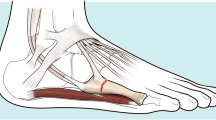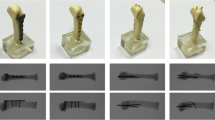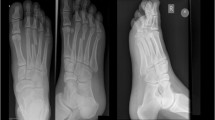Abstract
Most metatarsal neck fractures can be successfully treated non-operatively in a cast boot. Displaced metatarsal neck fractures tend to be less stable and have a propensity for the distal fragment to angulate, secondary to the strong flexor tendons, which often forces the distal fracture fragment in a plantar direction and leads to relative metatarsal shortening. Most literature is focussed on antegrade fixation of metatarsal neck fractures using pre-bent K wires or thin elastic nails. Apart from the technical challenges, this technique is limited when bones are osteoporotic as the pre-bent distal end of the K-wire may penetrate the plantar cortex of the proximal metatarsal and prevent the wire from entering the medullary canal of the metatarsal and advancing to the fracture site. Furthermore, when the medullary canal is narrow especially in Asian patients, it may be difficult to pass a bent K-wire through the isthmus of the metatarsal shaft. We describe an innovative technique of closed transverse wiring of the metatarsal head necks that has a distinct advantage in Asian population with osteoporotic bones. With percutaneous manipulation using digital pressure, closed reduction of fracture fragments of the most displaced fracture is done under fluoroscopic guidance to achieve a satisfactory alignment followed by closed transverse wiring of the metatarsal heads. With this procedure, adjacent fractures remain stable within an acceptable range because of intermetatarsal ligaments connected to the adjacent intact head. Our technique has a relatively short operating time and allows for early motion of the metatarso-phalangeal joint. This is especially useful for those with osteoporosis, narrow canal, soft tissue compromise, intra-operative failure of ante-grade pinning and in scenarios of limited surgical equipment/expertise.



Similar content being viewed by others
References
Cakir, H., Van Vliet-Koppert, S. T., Van Lieshout, E. M. M., De Vries, M. R., Van Der Elst, M., & Schepers, T. (2011). Demographics and outcome of metatarsal fractures. Archives of Orthopaedic and Trauma Surgery, 131(2), 241–245.
Zenios, M., Kim, W. Y., Sampath, J., & Muddu, B. N. (2005). Functional treatment of acute metatarsal fractures: a prospective randomised comparison of management in a cast versus elasticated support bandage. Injury, 36(7), 832–835.
Shereff, M. J. (1990). Fractures of the forefoot. Instructional Course Lectures, 39, 133–140.
Alepuz, E. S., Carsi, V. V., Alcántara, P., & Llabrés, A. J. (1996). Fractures of the central metatarsal. Foot and Ankle International, 17(4), 200–203.
Armagan, O. E., & Shereff, M. J. (2001). Injuries to the toes and metatarsals. Orthopedic Clinics of North America, 32(1), 1–10.
Pendarvis, J. A., Mandracchia, V. J., Haverstock, B. D., & Granquist, J. C. (1999). A new fixation technique for metatarsal fractures. Clinics in Podiatric Medicine and Surgery, 16(4), 643–657.
Baumfeld, D., Macedo, B. D., Nery, C., Esper, L. E., & Filho, M. A. B. (2012). Anterograde percutaneous treatment of lesser metatarsal fractures: technical description and clinical results. Revista Brasileira de Ortopedia (English Edition), 47(6), 760–764.
Kim, H.-N., Park, Y.-J., Kim, G.-L., & Park, Y.-W. (2012). Closed antegrade intramedullary pinning for reduction and fixation of metatarsal fractures. Journal of Foot and Ankle Surgery, 51(4), 445–449.
Hettchen, M., Strauss, A., Pennekamp, P., Burger, C., Weber, O., & Müller, M. (2015). Elastisch stabile intramedulläre Nagelung (ESIN) von Mittelfußfrakturen. Z Für Orthop Unfallchirurgie, 154(02), 148–156.
Aguado, H. J., Herranz, P. G., & Rapariz, J. M. (2003). Metaizeau's technique for displaced metatarsal neck fractures. Journal of Pediatric Orthopaedics Part B, 12(5), 350–353.
Bryant, T., Beck, D. M., Daniel, J. N., Pedowitz, D. I., & Raikin, S. M. (2018). Union rate and rate of hardware removal following plate fixation of metatarsal shaft and neck fractures. Foot and Ankle International, 39(3), 326–331.
Verzin, E. J., & Henderson, S. A. (2000). A new technique for the management of difficult metatarsal neck fractures. Foot and Ankle International, 21(10), 868–869.
Dutkowsky, J., & Freeman, B. L. (1989). Fracture-dislocation of the articular surface of the third metatarsal head. Foot Ankle., 10(1), 43–44.
Singer, G., Cichocki, M., Schalamon, J., Eberl, R., & Höllwarth, M. E. (2008). A study of metatarsal fractures in children. Journal of Bone and Joint Surgery. American Volume, 90(4), 772–776.
Sammarco, G. J., & Carrasquillo, H. A. (1995). Intramedullary fixation of metatarsal fracture and non-union. Two methods of treatment. Orthopedic Clinics of North America, 26(2), 265–272.
McDonald, R., Longfellow, J., Parkinson, D., & Edelman, R. (1986). Multiple traumatic fractures of the lesser metatarsals. A case report. The Journal of the American Podiatric Medical Association, 76(5), 283–286.
Donahue, M. P., & Manoli, A. (2004). Technical tip: transverse percutaneous pinning of metatarsal neck fractures. Foot & Ankle International. https://doi.org/10.1177/107110070402500615.
Galal, S., & Safwat, W. (2017). Transverse pinning versus intramedullary pinning in fifth metacarpal’s neck fractures: A randomized controlled study with patient-reported outcome. Journal of Clinical Orthopaedics and Trauma. https://doi.org/10.1016/j.jcot.2017.05.015.
Potenza, V., Caterini, R., De Maio, F., Bisicchia, S., & Farsetti, P. (2012). Fractures of the neck of the fifth metacarpal bone. Medium-term results in 28 cases treated by percutaneous transverse pinning. Injury. https://doi.org/10.1016/j.injury.2011.10.036.
Author information
Authors and Affiliations
Corresponding author
Ethics declarations
Conflict of interest
The authors declare that they have no conflict of interest.
Ethical standard statement
This article does not contain any studies with human or animal subjects performed by the any of the authors.
Informed consent
For this type of study informed consent is not required.
Additional information
Publisher’s Note
Springer Nature remains neutral with regard to jurisdictional claims in published maps and institutional affiliations
Rights and permissions
About this article
Cite this article
Goel, N.K., Khurana, A., Narula, V. et al. Closed Transverse Pinning for Reduction and Fixation of Metatarsal Neck Fractures: Surgical Technique. JOIO 55, 758–762 (2021). https://doi.org/10.1007/s43465-020-00170-y
Received:
Accepted:
Published:
Issue Date:
DOI: https://doi.org/10.1007/s43465-020-00170-y




